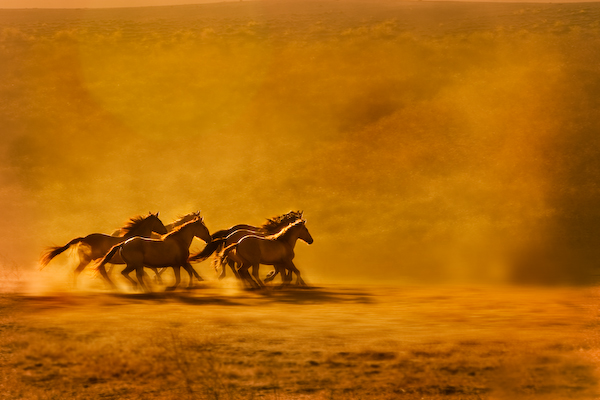 Ishari
(Vectorial)
Tafsir
(Exegesis)
of
Surah
Al-‘Ādiyāt
Ishari
(Vectorial)
Tafsir
(Exegesis)
of
Surah
Al-‘Ādiyāt
Discussion Join
Content:
Wa the galloping panting quadruped-animals
Fa The Fire Emitter(s) Sparkling
Fa Rapid-Movers At-Dawn
Fa They (female plural) followed Bi-Hi (him, by him,
it) Dust-raising
Fa (they female plural) gathered to the middle Bi-Hi
(by him, him, it) Assembling
Waw of Emergence: Rise to Higher Complexity of
Behavior
Nun of Symmetry Breakage: Herding Behavior
Jawāb (Reply) to the Qasam (Oath) of Wa: Inna (Divine
Actualizer) for Human Energetics
Impromptu
See Also:
http://www.untiredwithloving.org/sabbihi.html#tafsir_ishari
what
is
Ishari
Tafsir
http://www.untiredwithloving.org/grammar_states.html
http://www.untiredwithloving.org/surat_constraint.html
http://www.untiredwithloving.org/kitab_nun.html
http://www.untiredwithloving.org/kitab_al_waw.html
The first Harf (Divine
Alphabet) of the Surah is Wa which
is a Qasam
(Oath) taken by refering to the panting galloping horses. Association
of the Wa by
the gallloping horses (in plural form) is to aggrandize them,
as a collective, elevated even more
observable than other members of the creation, as Allah loves and
wills, and the agent
alphabet that does elevate the status of that creature is Waw:
100:1. Wa
the galloping panting quadruped-animals (four-legged animals
which pant
(noisy expirations) when gallop e.g. horse or dog)
وَالْعَادِيَاتِ
ضَبْحًا
The extraordinary molecular breathing apparatus of the galloping
animals when they pant is elevated to a mighty importance, Allah
loves the breathing inventinveness of such animals, Waw thus
serves as
a double-vector pointing towards Absent Divine
Presence and Divine Formative Creative Presence.
Remark: The Arab has taught the Muslims that
Al-‘Ādiyāt are galloping horses used in battle; horses were what they
loved the most; however reviewing all
Tafsirs of major scholars of Sunnis, Shiites and Sufis reveal no such
evidence whatsoever, direct or indirect. The Prophet peace be upon did
not say anything about the Al-‘Ādiyāt even being horses! Therefore the
readers should not be under any influence of such interpretation that
has no basis and thus occluded the resplendent beauty of one of the
most loved inventions of Allah i.e. the
respiratory system of exotic
servants such as horses and the other galloping quadrupeds.
Qurtubi
Al-‘Ādiyāt, female plural, is the galloping horses as most linguistic
scholars and
exegetes have ssaid i.e. galloping on the path of Allah thus
breathing
hard
(Dara: There is no direct evidence for Qurtubi to quote therefore he
wrote what most scholars said and left it at that)
Farra’: Dhabh (Panting) is the
sound of the horses once they gallop.
Ibn Abbas: There are no animals
that sound like the Dhabh (Panting) except the horse, the dog and fox.
(Dara: Given the fact that Ibn Abbas lived in almost life-less desert
we and was blind later on in life, Al-‘Ādiyāt can safely be any
galloping quadruped e.g. camel as indicated by other scholars.)
تفسير الجامع
لاحكام القرآن/ القرطبي (ت 671 هـ)
{ وَٱلْعَادِيَاتِ ضَبْحاً } * { فَٱلمُورِيَاتِ قَدْحاً }
قوله تعالى: { وَٱلْعَادِيَاتِ ضَبْحاً } أي الأفراس تعدو. كذا قال عامة
المفسرين وأهل اللغة؛ أي تعدو في سبيل الله فتضبح. قال قتادة: تضبح إذا
عدت؛ أي تحمحِم. وقال الفراء:
الضَّبْح: صوت أنفاس الخيل إذا عَدَوْن.
ابن عباس: ليس شيء من الدواب
يضْبَح غير الفرس والكلب والثعلب. وقيل: كانت تُكْعَم لئلا تصهَل،
فيعلم العدوّ بهم؛ فكانت تتنفس في هذه الحال بقوّة.
Dara:
If the Al-‘Ādiyāt refers to the horses that the Prophet rode on, as has
been speculated, then Qurtubi refers to Ibn Arabi:
Qurtubi
Ibn Arabi said: Allah issued
Qasam
(Oath) by the noun Ya-Sin and ‘your life (Muhammad)’ Hijr:72 and also
Allah issued Qasam by the horses the Prophet rode in this Surah and by
their powerful sparking hoofs and the dust they raised.
تفسير الجامع
لاحكام القرآن/ القرطبي (ت 671 هـ)
{ وَٱلْعَادِيَاتِ ضَبْحاً } * { فَٱلمُورِيَاتِ قَدْحاً }
قال ابن العربي: أقسم
الله بمحمد صلى الله عليه وسلم فقال:
{ يسۤ * وَٱلْقُرْآنِ ٱلْحَكِيمِ }
[يۤس: 1 ـ 2]، وأقسم بحياته فقال:
{ لَعَمْرُكَ إِنَّهُمْ لَفِي سَكْرَتِهِمْ يَعْمَهُونَ }
[الحجر: 72]، وأقسم بخيله وصهيلها وغُبارها، وقدح حوافرها النار من الحجر،
فقال: «والعادِيات ضَبْحا»... الآيات الخمس.
Shaukani
Al-‘Ādiyāt is the plural of ‘Ādiyat (female) i.e. fast moving extracted
from
‘Adu
and that verb means quick motion, but its Waw was
exchanged with Ya
(‘y’ in Arabic) due to the Kasra before it.
Dhabh-an is the Masdar (Verbal Noun) and emphasis for the Ism-Fa’il
(Agent/doer Noun). Also Dhabh-an can be a Masdar (Verbal Noun) for the
semantics of Hala (Characteristic) i.e. these horses are endued with
the respiratory system for galloping.
تفسير فتح القدير/ الشوكاني (ت 1250 هـ)
العاديات جمع عادية. وهي
الجارية بسرعة، من العدو: وهو المشي بسرعة، فأبدلت الواو ياء لكسر ما
قبلها كالغازيات من الغزو. والمراد بها الخيل العادية في الغزو نحو
العدوّ. وقوله: { ضَبْحاً }
مصدر مؤكد لاسم الفاعل. فإن الضبح نوع من السير، ونوع من العدو.
يقال ضبح الفرس: إذا عدا بشدّة، مأخوذ من الضبع، وهو الدفع، وكأن الحاء
بدل من العين. قال أبو عبيدة، والمبرد: الضبح من إضباحها في السير ومنه
قول عنترة:
والخيل تكدح في حياض الموت ضبحا
ويجوز أن يكون مصدراً في موضع
الحال، أي: ضابحات، أو ذوات ضبح، ويجوز أن يكون مصدراً لفعل محذوف،
أي: تضبح ضبحاً. وقيل الضبح: صوت حوافرها إذا عدت. وقال الفراء: الضبح صوت
أنفاس الخيل إذا عدت، قيل كانت تكعم لئلا تصهل، فيعلم العدوّ بهم، فكانت
تتنفس في هذه الحالة بقوّة، وقيل الضبح: صوت يسمع من صدور الخيل عند العدو
ليس بصهيل. وقد ذهب الجمهور إلى ما ذكرنا من أن { العاديات ضبحاً } هي الخيل. وقال عبيد بن
عمير، ومحمد بن كعب والسديّ: هي
الإبل، ومنه قول صفية بنت عبد المطلب:
فلا والعاديات غداة جمع
بأيديها إذا صدع الغبار
ونقل أهل اللغة أن أصل الضبح للثعلب، فاستعير للخيل، ومنه قول الشاعر:
تضبح في الكف ضباح الثعلب
Q: Why did Allah issue the
Qasam (Oath) via the Waw?
A: Wa
is the Harf (Divine
Alphabet) the agent that operates upon any member
of the creation whom Allah
loves or Allah holds with regard or assigns
immense importance to. This is the agent alphabet that elevates and
thus
renders the importance of an entity—High Complexity.
Without Waw
universe is flat i.e. there is no variation of importance
amongst the objects, and how can there be a Divine Lover without
preferences? How can the universe point to a Singleton Lover unless
there is the asymmetry of ITs
Divine Love? And if it was so nothing would have been beautiful.
Therefore Allah
ennobled the galloping animals and that has entered
into the Hadith which deals with seeing Allah on the Day of
Resurrection when
Allah repeatedly questions the human beings about their ingratitude for
all the gifts they received including the galloping animals like horses
and camels that were domesticated:
"Didn't I (Allah)
domesticate
the
horse
and
the
camel
for
you?"
زيادة الجامع الصغير،
والدرر المنتثرة، - للإمام السيوطي
كتاب "زيادة الجامع الصغير"، للسيوطي >> حرف الهاء
3407- هل تضارون في رؤية الشمس في الظهيرة ليست في سحابة، هل تضارون في
رؤية القمر ليلة البدر ليس في سحابة، فوالذي نفسي بيده لا تضارون في رؤية
ربكم عز وجل إلا كما تضارون في رؤية أحدهما فيلقى العبد فيقول: أي فل ألم
أكرمك، وأسودك وأزوجك، وأسخرك
الخيل والإبل، وأذرك ترأس وتربع؟ فيقول: بلى أي رب فيقول: أفظننت
أنك ملاقي؟ فيقول: لا فيقول: فإني أنساك كما نسيتني ثم يلقى الثاني فيقول
له: أي فل ألم أكرمك، أسودك، وأزوجك، وأسخر لك الخيل والإبل،
وأذرك ترأس وتربع؟ فيقول: بلى أي رب، فيقول: أفظننت أنك ملاقي؟ فيقول: لا،
فيقول: إني أنساك كما نسيتني، ثم يلقى الثالث فيقول له: مثل ذلك، فيقول:
رب آمنت بك وبكتابك وبرسلك وصليت وصمت وتصدقت ويثني بخير ما استطاع فيقول:
ههنا إذن، ثم يقال: الآن نبعث شاهدا عليك ويتفكر في نفسه من ذا الذي شهد
علي؟ فيختم على فيه، ويقال لفخذه: انطقي فتنطق فخذه ولحمه وعظامه بعمله،
وذلك ليعذر من نفسه، وذلك المنافق، وذلك الذي يسخط الله عليه.
(م) عن أبي هريرة.
Dara: There are thousands of small animals that are impossible to
domesticate e.g. most venomous snakes and cats (even small ones);
however the incredibly large camel and most powerful horses are
domesticated with ease. As human being is endued with nobility by being
close to Allah,
Wa
elevates the horses and other domesticated galloping
quadrupeds thus Wa endues them with nobility (Complexity) due to the
pupose-full creation and the consequent utility for
human beings.
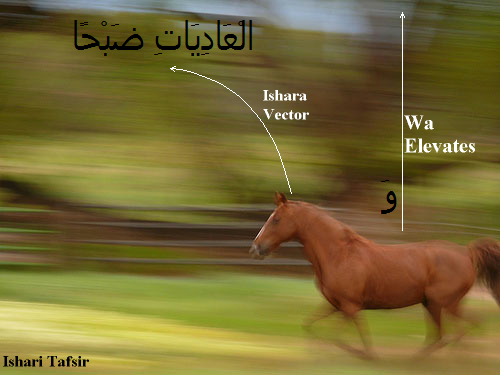
100:2. Fa The Fire Emitter(s) Sparkling
فَالْمُورِيَاتِ قَدْحًا
تفسير تفسير القرآن
الكريم/ ابن كثير (ت 774 هـ)
{ فَٱلمُورِيَـٰتِ قَدْحاً } يعني: اصطكاك نعالها للصخر، فتقدح منه النار،
تفسير فتح القدير/ الشوكاني (ت 1250 هـ)
{ فَٱلمُورِيَـٰتِ قَدْحاً } هي الخيل
حين توري النار بسنابكها. والإيراء
إخراج
النار، والقدح الصكّ، فجعل ضرب
الخيل بحوافرها كالقدح بالزناد.
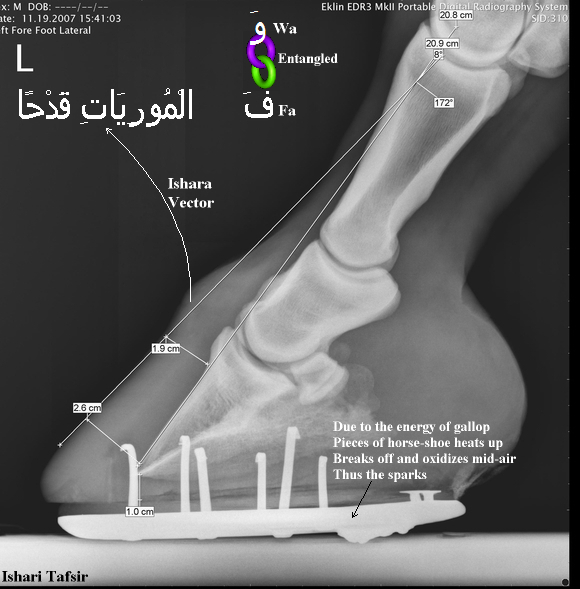
Horse Energetics
A. E. MINETTI, L. P. ARDIGÒ, E.
REINACH AND F. SAIBENE
The highly specialised evolution, with lengthening of the distal limbs
and
progressive reduction in the number of toes from five to one
(Hildebrand, 1994), and thousands of years of selective
breeding for speed and endurance have also made the horse an
outstanding power generator. In fact, its maximum aerobic
power output is 3.5 times higher than the value predicted by
general mammalian allometric equations (Taylor et al., 1981).
At speeds of approximately 10.5 and 16ms-1, for long-duration
and sprinting bouts, respectively, the horse is one of the fastest
quadrupeds on Earth.
Source: The Journal
of Experimental Biology 202, 2329–2338 (1999) 2329
Printed in Great Britain © The
Company of Biologists Limited 1999 JEB2261
100:3. Fa Rapid-Movers At-Dawn
فَالْمُغِيرَاتِ صُبْحًا
Circadian Rhythm
administrates the energy consumption of the horse at dawn for it to
move fast at the daybreak and the highly specialized leg-bone
inter-lock design allows for the horse to move instantly and
rapidly even during deep sleep:
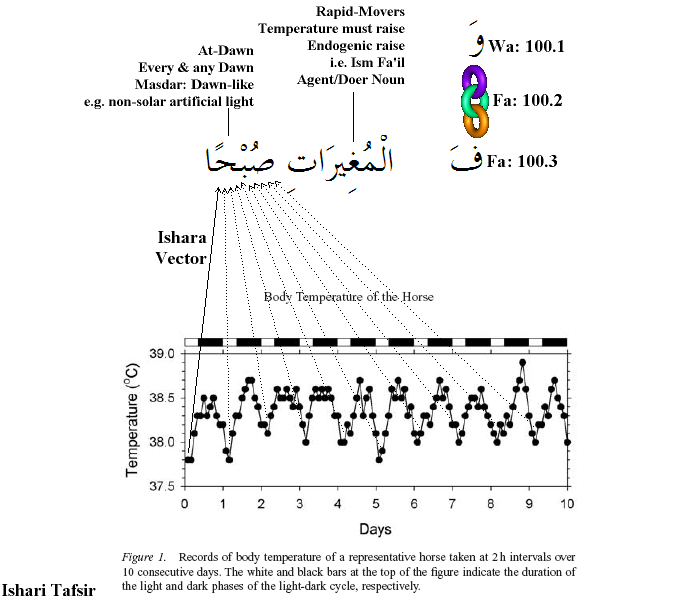
Click on the image for the source.
How horses sleep?
Your horse has a sort of internal hammock-a system of tendons and
ligaments called the stay apparatus. This system lets him lock his legs
in position so (unlike you) he can relax his muscles and doze off
without keeling over. Even when he's not sleeping, he uses the stay
apparatus to rest muscles and reduce fatigue. Being able to sleep
standing up is a great advantage for a prey animal. If a mountain lion
comes creeping through the underbrush, the horse can be off and running
without wasting precious seconds struggling to his feet. Horses plan
for a quick getaway in choosing resting places, too. Out in the open,
they go for sheltered areas but position themselves to get out
fast--butts to the windbreak, heads pointing toward a likely escape
route. "They're like volunteer firemen who back their cars into parking
spaces so they can pull out fast," Sue McDonnell says.
Equine Stay Apparatus
"Horses can stand on their feet for long periods, much longer than
other domestic animals,"
says Dr. Gerald J. Pijanowski, professor of morphology at the
University of Illinois College
of Veterinary Medicine at Urbana. "This enables them to rest and doze
and still be
prepared take flight in a second's notice if need be. If they were
lying down when a
predator arrived, the time it would take to get to their feet and get
moving could cost them
their lives.
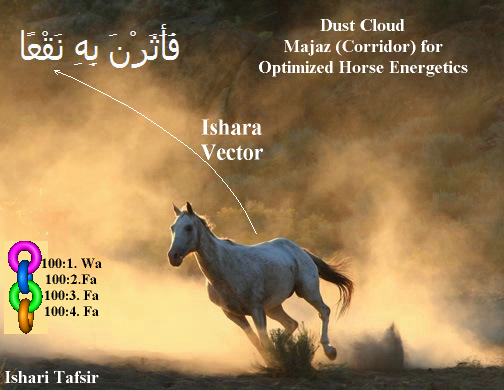
See Also: http://www.untiredwithloving.org/majaz.html
فَأَثَرْنَ بِهِ نَقْعًا
100:4. Fa They (female plural) followed Bi-Hi (him, by him, it)
Dust-raising
لسان
العرب ابن منظور
أثر
ويقال: آثَرَ كذا وكذا بكذا وكذا أَي
أَتْبَعه إِياه؛ ومنه قول متمم بن نويرة يصف الغيث: فَآثَـرَ سَـيْلَ
الـوادِيَّيْنِ بِــدِيمَةٍ تُرَشِّحُ وَسْمِيّاً، من النَّبْتِ،
خِرْوعا
أَي أَتبع مطراً تقدم بديمة بعده.
If we follow the convenient interpretation of the Arab that these are
horses in battle field, first we notice that the verb is for female
horse (mare) and second the pronoun Bi-Hi is referring to a male
entity. Imam Razi quotes Farrā’ that this male pronoun refers to the
place of the battle and quoting Kasā’i the male pronoun refers to the
time of the battle!
It is clear from these inadequate inferences that if the meaning of the
plural female ‘they’ should be the female horse (mare) then the male
pronoun Bi-Hi makes little sense as the place or time. What about the
Bi-Hi referring to the stallion the male horse:
Role of the lead
mare
Contrary to traditional portrayals of
the herd
stallion as the "ruler"
of a "harem" of females, the actual leader of a wild or feral herd is
the alpha or dominant mare, commonly known as the "boss mare" or "lead
mare." She is usually one of the more mature animals, responsible for
the overall safety of the herd, familiar with the terrain and resources
available. She takes the lead when the herd travels, determines the
best route, when to move from one place to another, and claims the
right to drink first from watering holes and stake out the best
location for grazing.
Role of the
stallion
The edge of the herd is the domain
of
the herd stallion, who must fight
off both predators and other males. When the herd travels, the stallion
brings up the rear, watching for predators and driving straggling herd
members on, keeping the group together. During mating season, stallions
tend to act more aggressively, in order to keep the mares from straying
off.
Source: http://en.wikipedia.org/wiki/Horse_behavior
Therefore Al-‘Ādiyāt refers to the plural form of female horse (mare)
as the leaders of the horse herds, and Bi-Hi
refers to the stallions
that guard and organize the horses into well behaved small packs to
follow the lead mare. Naq’an (Dust-raising) is added as a Masdar
(Verbal Noun) in order to emphasize the collective gallop of the herd,
as an attribute or character; and being so under the leadership of the
mare the latter is
possible by means of the coordination and management of the stallions.
تفسير
مفاتيح الغيب ، التفسير الكبير/ الرازي (ت 606 هـ)
{ فَأَثَرْنَ بِهِ نَقْعاً }
ففيه مسائل:
المسألة الأولى: في النقع قولان:
أحدهما: أنا هو الغبار وقيل: إنه مأخوذ من نقع الصوت إذا ارتفع، فالغبار
يسمى نقعاً لارتفاعه، وقيل: هو من النقع في الماء، فكأن صاحب
الغبار غاص
فيه، كما يغوص الرجل في الماء والثاني: النقع الصباح من قوله عليه
الصلاة
والسلام: " مالم يكن نقع ولا لقلقة " أي فهيجن في المغار عليهم صياح
النوائح، وارتفعت أصواتهن، ويقال: ثار الغبار والدخان، أي ارتفع وثار
القطا عن مفحصه، وأثرن الغبار أي هيجنه، والمعنى أن الخيل أثرن الغبار
لشدة العدو في الموضع الذي أغرن فيه.
المسألة الثانية: الضمير في قوله: {
به
} إلى ماذا يعود؟ فيه وجوه أحدها: وهو قول الفراء أنه عائد إلى المكان
الذي انتهى إليه، والموضع الذي تقع فيه الإغارة، لأن في قوله: {
فَٱلْمُغِيرٰتِ صُبْحاً } دليلاً على أن الإغارة لا بد لها من وضع، وإذا
علم المعنى جاز أن يكنى عما لم يجز ذكره بالتصريح كقوله:
{ إِنَّا أَنزَلْنَـٰهُ فِى لَيْلَةِ
ٱلْقَدْرِ }
[القدر: 1] وثانيها: إنه عائد إلى ذلك
الزمان الذي وقعت فيه الإغارة، أي فأثرن في ذلك الوقت نقعاً
وثالثها: وهو
قول الكسائي أنه عائد إلى العدو، أي فأثرن بالعدو نقعاً، وقد تقدم ذكر
العدو في قوله: { وَٱلْعَـٰدِيَـٰتِ }.
المسألة الثالثة: فإن قيل: على أي
شيء
عطف قوله: { فَأَثَرْنَ } قلنا: على الفعل الذي وضع اسم الفاعل
موضعه،
والتقدير واللائي عدون فأورين، وأغرن فأثرن.
المسألة الرابعة: قرأ أبو حيوة: {
فَأَثَرْنَ } بالتشديد بمعنى فأظهرن به غباراً، لأن التأثير فيه معنى
الإظهار، أو قلب ثورن إلى وثرن وقلب الواو همزة.
فَوَسَطْنَ بِهِ جَمْعًا
100:5. Fa (they female plural) gathered to the middle Bi-Hi (by him,
him, it) Assembling
‘Gathered to the middle’ is the verb Wasata which has two meanings:
1. Gathering to the middle of something then the
verse means the female horses surrounded by the stallion (Hi) who is
instrumental (Bi) to assemble the herd
2. Wasat means the best part of something i.e. by
means of the stallion the female horses perfected the assembly of a
herd.
لسان العرب ابن
منظور
وفي الحديث: الوالِد أَوْسَطُ أَبواب الجنة أَي خيرُها. يقال: هو من
أَوسَطِ قومِه أَي خيارِهم. وفي الحديث: أَنه كان من أَوْسَطِ قومه أَي من
أَشْرَفِهم وأَحْسَبِهم.
وفي التنزيل العزيز: وكذلك جَعَلْناكم أُمّة وسَطاً؛ قال الزجاج: فيه
قولان: قال بعضهم وسَطاً عَدْلاً، وقال بعضهم خِياراً، واللفظان مختلفان
والمعنى واحد لأَن العَدْل خَيْر والخير عَدْلٌ، وقيل في صفة النبي، صلّى
اللّه عليه وسلّم: إِنه كان من أَوْسَطِ قومِه أَي خِيارِهم، تَصِف
الفاضِلَ النسَب بأَنه من أَوْسَطِ قومه، وهذا يَعرِف حقيقَته أَهلُ اللغة
لأَن العرب تستعمل التمثيل كثيراً، فَتُمَثِّل القَبِيلةَ بالوادي والقاعِ
وما أَشبهه، فخيرُ الوادي وسَطُه، فيقال: هذا من وَسَط قومِه ومن وَسَطِ
الوادي وسَرَرِ الوادي وسَرارَته وسِرِّه، ومعناه كله من خَيْر مكان فيه،
وكذلك النبي، صلّى اللّه عليه وسلّم، من خير مكان في نسَب العرب، وكذلك
جُعِلتْ أُمّته أُمة وسَطاً أَي خِياراً.
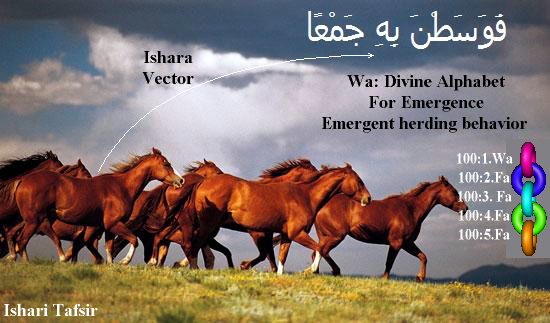
Waw of Emergence: Rise to Higher
Complexity of Behavior
Alex Ryan
Definition (Emergent property). A property is emergent if & only if
it is present in a macrostate and it is not present in the microstate.
Source: arXiv:nlin/0609011v1 [nlin.AO] 6 Sep 2006
Microstate: Organic molecules,
bones, tandems and all the other elements that comprise a horse.
Macrostate: Gallop, Circadian
Rhythm, optimized energy expenditure, herding behavior.
Note: See Ibn Arabi Micro/Macro
state and two Waw(s).
The leadership of Al-‘Ādiyāt or the mare as a collective and the
utility and management of the stallion (Bi-Hi) are emergent properties
of the molecules, muscles, tandems and all elements that comprise the
horse. By simply looking at the Microstate very little of the herding
behavior of the horse is uncovered, only observations during the
Macrostate reveal the de novo galloping and herding behavior.
Waw is
the Harf (Divine
Alphabet) that elevates the status of the horse
as a mere molecular kinmematically optimized machine into a living
behaving affectionate or
aggressive entity with astonishing physiology (Circadian Rhythm)
and
psychology
(Herding
Behavior)—Emergence
(Zuhur).
Or you might say: The Qasam
(Oath) of Waw (Divine Alphabet of W) elevates the complexity of the
horse from corporeal to a behaving psychological entity, closer to
Al-‘Ala (The Lofty, Allah) than the
un-living molecules, limbs and
so on.
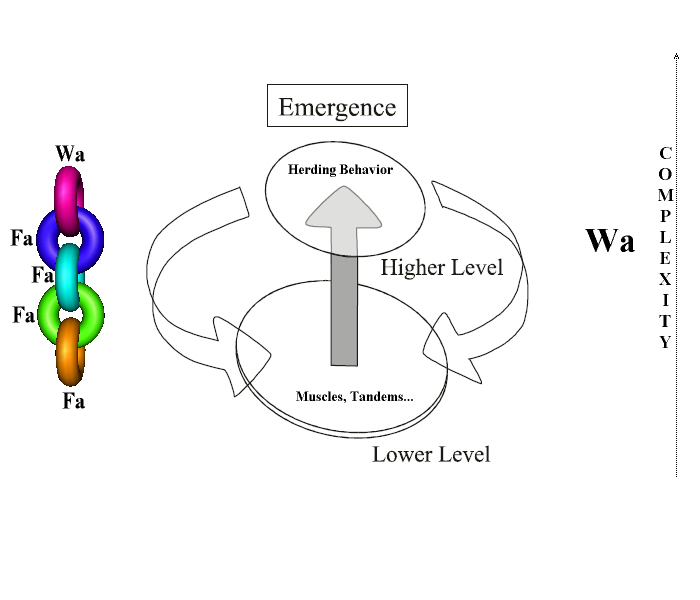
Nun of Symmetry Breakage: Herding
Behavior
Asymmetric aggregation of animals under panic conditions has been
observed in many species, including humans, mice, and ants. Theoretical
models have demonstrated symmetry breaking similar to observations in
empirical studies. For example when panicked individuals are confined
to a room with two equal and equidistant exits, a majority will favor
one exit while the minority will favor the other.
Source: http://en.wikipedia.org/wiki/Herd_behavior
Verbal Nouns (Masdar) in state of Nunation (Tanwin, the ending ‘an’
nasalization) i.e. Dhabh-an (Panting), Qadh-an (Sparkling), Subh-an
(At-Dawn), Naq’an (Dust-raising) and Jam’an (Assembling) all have the
ending Nun (N sound) that causes the nasalization; an indication for
the asymmetrical configuration i.e. the asymmetric herding behavior.
Haraka (Oral
Motion) of Fat-ha (‘a’
sound) with list complexity for
oral movements indicates the deep infinite past voyage of the herding
behavior from Qidam (Infinite
Past) to the present, thus as a Masdar
(Verbal Noun), to render the rise from the lowest of all complexities
of infinite past emerging towards the mid-level complexities of the
horse herding behavior as an Ishara (Vectorial Pointing) at the Divine
Presence that has the raised the nobility of the concrescence of this
entity i.e. the galloping quadrupeds e.g. horse.
Q: Why Fa and not just more of Wa?
A: Arab used Fa in place of Wa to
fix an order between the sentences i.e. the 100:2 cannot be switched
with 100:3. In order to capture this order of the verses and their
potential causal chain the ideogram of lined chains is used.
Jawāb (Reply) to the Qasam (Oath) of
Wa:
Inna
(Divine Actualizer) for Human
Energetics
Wa
elevates the design and instantiation of the molecular horse upwards
into the emergent behavior of a herding quadruped
with most efficient
energetics; all the while human being observes from the molecular
structures to the herding psychology of the horses and so concludes
that all
such inventive designs were crafted for the single purpose of his
utilization (reuse)
and many more similar designs are
found within himself with even more inventiveness and optimization:
Michael Sockol, David A. Raichlen, and
Herman Pontzer
Bipedal walking is evident in the earliest hominins, but why our unique
two-legged gait
evolved remains unknown. Here, we analyze
walking
energetics and biomechanics for adult chimpanzees and humans to
investigate the long-standing hypothesis that bipedalism reduced the
energy cost of walking compared to our ape-like ancestors. We find that human walking is 75%
less costly than chimpanzee walking due to our more extended hip and a
longer hindlimb, features present in early fossil hominins.
Analyses of bipedal walking in chimpanzees indicate that bipedalism in
early, ape-like hominins could indeed have been less costly than
quadrupedal knucklewalking.
Source: Chimpanzee Locomotor Energetics and the
Origin of Human Bipedalism
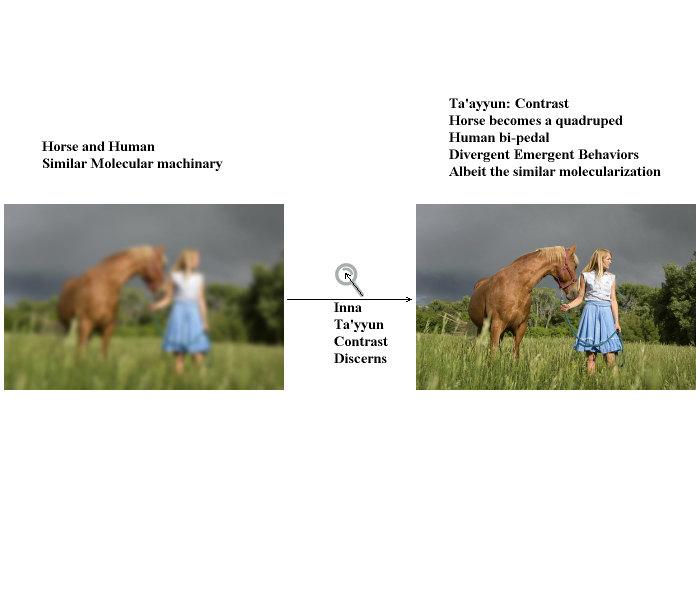
100:6. Inna
Al (The) Human Being (genus) for his Lord (is) La Kanud
(Infertile Land)
إِنَّ
الْإِنْسَانَ
لِرَبِّهِ
لَكَنُودٌ
Inna: Serves as immix of a
pointer with a lens pointing at the Panorama of
Tauhid (Divine Oneness)
and thus a region is increased in contrast, the description and
characterization of that region is adumbrated by what follows of words
after Inna. Moreover Inna is used i.e. beginning with Kasra as opposed
with Fat-ha therefore it is a form of a statement issues about the
nature or reality of humanity. Inna brings Human Being under a focus
discerned from all else.
Al: Alif+Lum is the definite
article that refers to the noun 'human being' as the genus of all
humans. What follows depicts not just regarding to a single human being
but humanity as a collective.
La: Lum+Fat-ha indicates that
Kanud is delayed towards the end of the verse and it actually relates
to the Inna.
This
Lum
is
called
Lum
of
Muzhalaqa.
Therefore the verse
can also read as (Al-Anbari
Al-Bayan Fi Irab Gharib Al-Qur’an):
إِنَّ
الْإِنْسَانَ
لَكَنُودٌ
لِرَبِّهِ
مفرداتُ
ألفاظِ
القرآن
كند
قوله تعالى
إِنَّ الْإِنْسَانَ لِرَبِّهِ لَكَنُودٌ
أي كفورٌ لنعمته كقولهم أرضٌ كنودٌ إذا
لم تنبت شيئأً
Anna and Inna point towards the Sidrat
Al-Muntaha the botanical end of multiverse and no one and nothing
can divert their direction except human being (Kanud), even a single
man, can divert the vector of their Ishara (Pointing) towards awesome
destruction and loss i.e. a barren landscape (Kend). And Allah
completes this diversion as the end on this earth:
18:8. Verily what is on her (earth) We (Allah) shall
make but as dust
and dry soil (without growth or herbage).
وَإِنَّا لَجَاعِلُونَ مَا
عَلَيْهَا صَعِيدًا جُرُزًا
The universe is shaped by the Surat (Constraint)
of
the
humanity
being
ingrate
and
arrogant
and
the Lord of Multiverse most generous and
inventive. And as such the Inna
provides a linguistic description of
the said Surat (Constraint) that shapes the universe.
100:7. Wa
(And) Inna-hu
(it,
he)
over
Za-Li-Ka
(That,
addressed
for
you
Muhammad) witness
وَإِنَّهُ عَلَى ذَلِكَ
لَشَهِيدٌ
وَإِنَّهُ لَشَهِيدٌ عَلَى ذَلِكَ
Hu: Noun for Inna,
meaning he
or it, this noun could refer to the human being as a genus or to Allah.
Za-Li-Ka: Za is the single
letter meaning ‘this’ and ‘Li’ extends the reach of ‘this’ to a farther
distance i.e. ‘that over there’ and Ka (you) for Muhammad peace be upon
him. This is the Prophetic Presence of Muhammad, not his biological
presence, he is within the state of Insan Kamil (Perfected Eye) and
stares from there (Malakut
the realm of spirits) to here (Mulk
the
corporeal realm) to see that either Allah or
humanity or both are
witness over the incredible gifts and generosity of Allah e.g.
Circadian Rhythm,
optimized
quadruped
horse
genetics
and
superbly
engineered
and
optimized bipedal walking of human beings.
100:8. Wa
(And) Inna-hu
for
the
love
of
(worldly
goodness)
intense
(intensely
loves material stuff)
وَإِنَّهُ
لِحُبِّ
الْخَيْرِ
لَشَدِيدٌ
وَإِنَّهُ لَشَدِيدٌ لِحُبِّ
الْخَيْرِ
Remark: Wa in
100:7-8 is used as ‘and’ stringing
along the sentences and the order might not matter.
Impromptu
Sabāhan at dawn, horses awakened and thus galloping at the early rays
of the dawn, or the Migrating
Monarch butterflies migrating from Eastern North America to Central
Mexico, both guided by the Circadian Rhythm
molecularly programmed
within their genome, are Tajalli (Lucent
Manifestation) enacting the
exposure to the Nur (Divine Light)
whereupon
non-being
is
lit
to
be
and
non-living
resplendent with life. Horses gallop at the early light of
the day as we run with our existence and life is non-stop at the very
first
ray of the Nur.
‘Ighāra (Gallop) is the Tasbih (Sanctification)
of
the
horse—each
creature
is
optimized
for
certain
emergent behavior e.g. birds flying,
fish swimming and each of their emergent behaviors are Tasbih
for the
Formative Creator i.e. sanctification that singles out the Divine
Innovator from all the rest of the innovators; as are the speech and
emotions of a servants who sanctifies Allah above and
beyond all else.
Naqa’ (Raising of the dust) due to the gallop is the Adab (Etiquette)
of the horse during the Tasbih (Sanctification)
of
the
‘Ighāra
(Gallop);
as
is
the
humming
of the low voice and stillness of the
sitting of the servant serve as the etiquette for sanctification of
Allah.
Jam’ (Assembling) of the herd of horses is
the communal Tasbih
(Sanctification)
of
the
pact
in
unison;
male
stallion
serves as the
Imam (Leader in front to follow) or the defender warding off the devil;
mare the female horse serves as the Murshida (Guide) to waters of Ilm
(Learnt Knowledge) and pastures of Irfan (Unlearnt Knowledge). Without
the stallion there might is no herd, just scattered horses, but without
the mare there is no horse!
Baqli
Allah has
issued a Qasam (Oath) by the horses of the hearts of the
lovers, during the gallop of the souls of the unrestrained lovers at
the dawn of the observations of Divine Attributes.
تفسير عرائس
البيان في حقائق القرآن/ البقلي (ت 404 هـ)
اقسم الحق سبحانه بافراس قلوب المحبين اذا صحبت باصوات الوصلة من تراكم
مواجيد المشاهدة فى ميادين الوحدة حين عاينت مشاهدة السرمدية وهى الموريات
انوار المعارف من قداح الكواشف ثم اقسم لواردات كشوف صفاته حين اغارت
ارواح العاشقين عند طلوع صباح مشاهدته.
© 2010-2002, Dara O
Shayda
 Ishari
(Vectorial)
Tafsir
(Exegesis)
of
Surah
Al-‘Ādiyāt
Ishari
(Vectorial)
Tafsir
(Exegesis)
of
Surah
Al-‘Ādiyāt






